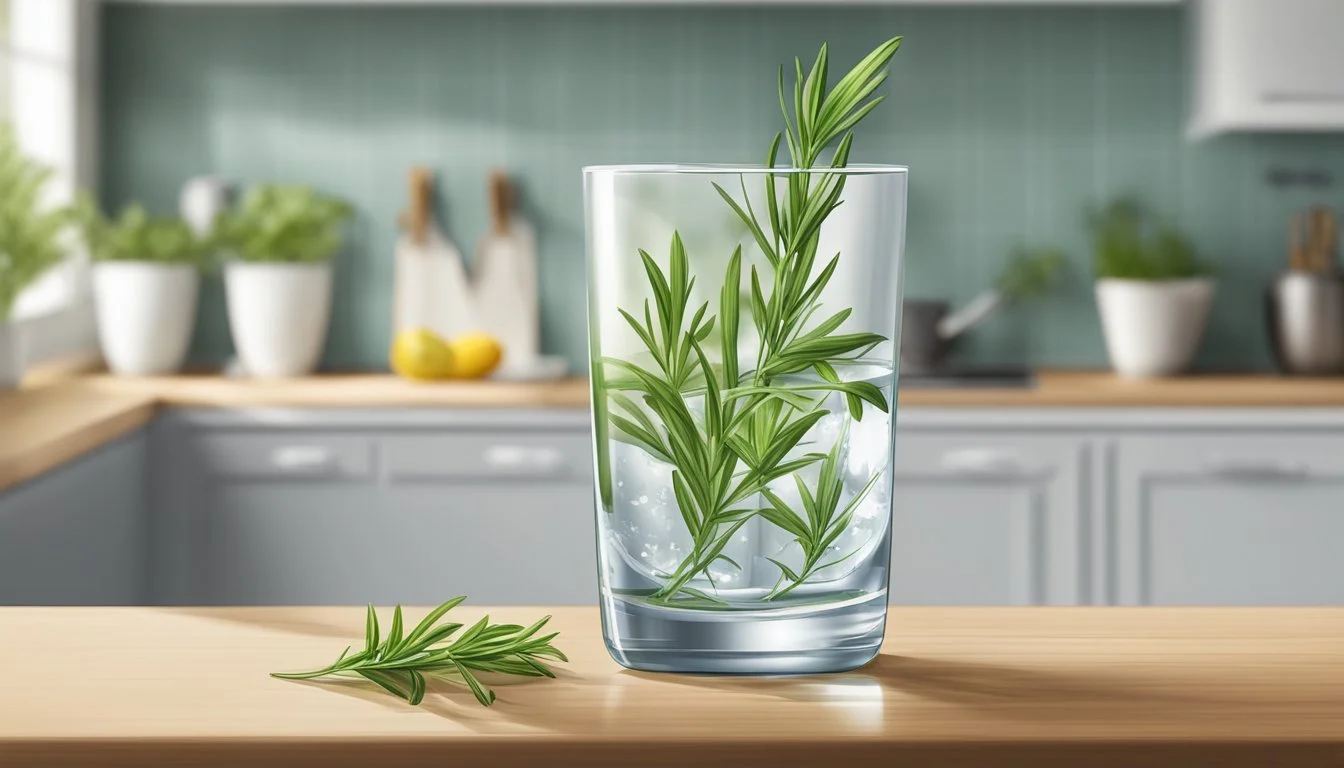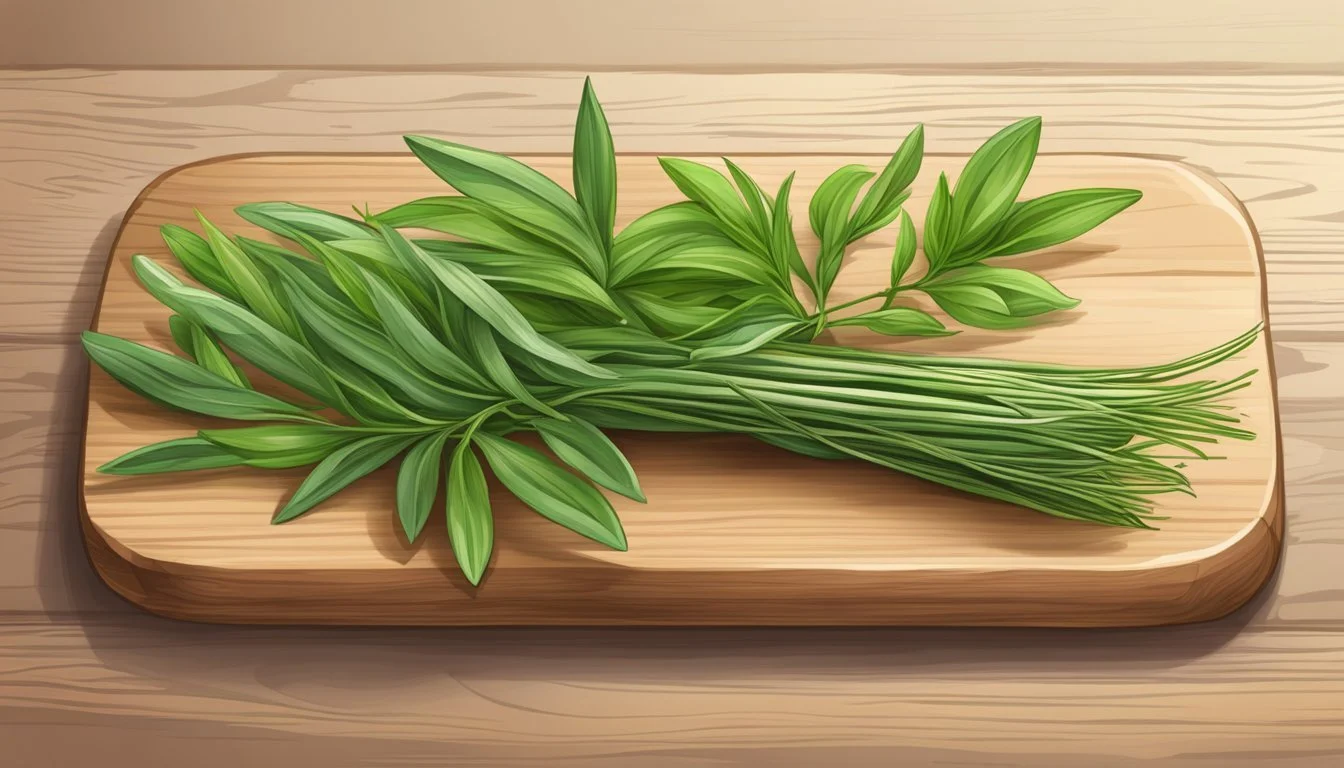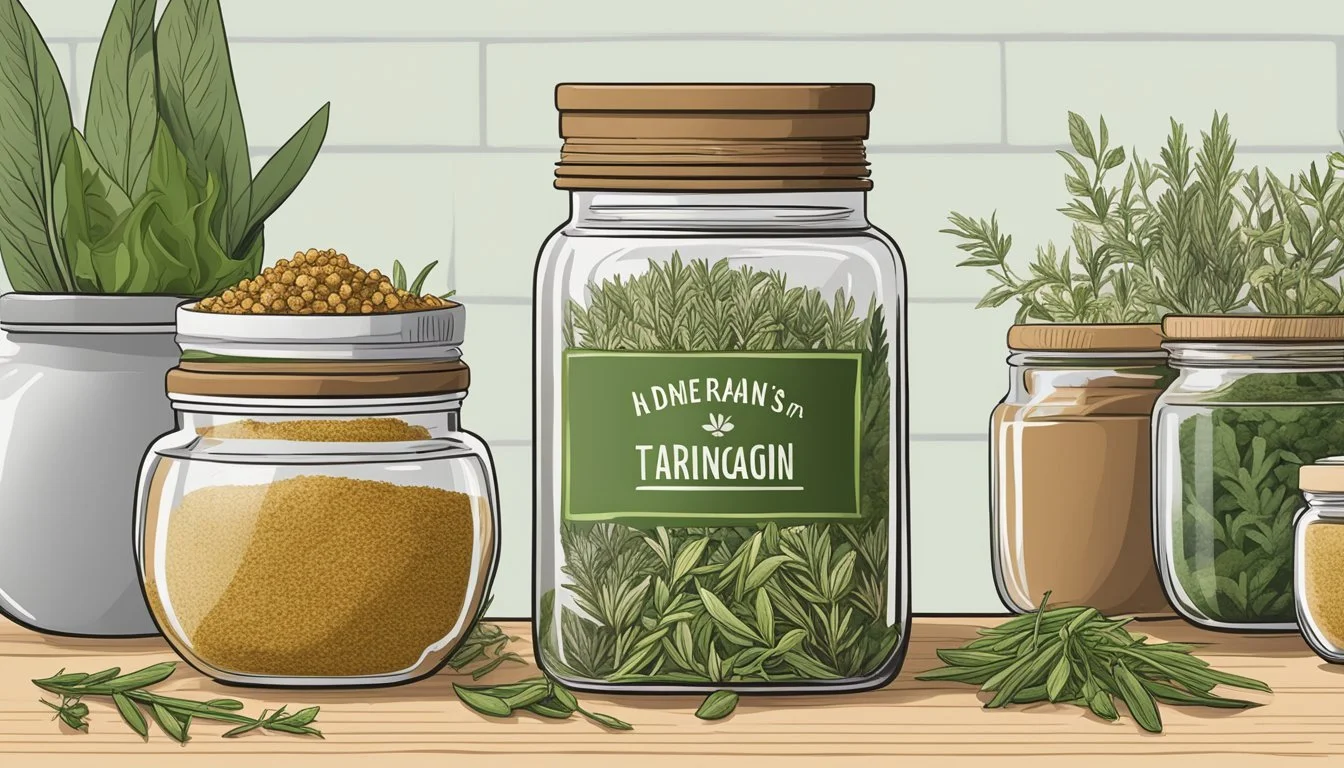How Long Does Tarragon Last?
Shelf Life and Storage Tips
Tarragon is a perennial herb prized for its aromatic leaves which offer a distinctive, albeit delicate, flavor in cooking. Often associated with French cuisine, this herb is a key component in a plethora of dishes, including the classic Béarnaise sauce. Tarragon's flavor, which has hints of anise, complements a wide range of foods like fish, chicken, and eggs. Its use is not limited to French culinary practices; globally, it enhances the taste of various recipes, ensuring its status as a versatile herb in the kitchen.
The longevity of tarragon is a common query among culinary enthusiasts and home cooks. When stored properly, fresh tarragon can retain its quality for up to two weeks in the refrigerator. This involves either wrapping the herb in a damp paper towel and placing it in a plastic bag or immersing the stems in a glass of water, with a plastic bag loosely covering the leaves.
For extended use beyond a couple of weeks, tarragon can be frozen, which preserves its flavor for up to six months. While drying is a common method for preserving herbs, it is less ideal for tarragon, as drying can significantly diminish its aromatic oils and flavor. Consequently, those looking to maintain the integrity of tarragon's unique taste tend to prefer either refrigeration or freezing as preservation methods.
Understanding Tarragon
Tarragon is a distinctive herb known for its aromatic leaves and culinary versatility. It belongs to the sunflower family and is coveted for its unique flavor profile.
Botanical Profile
Tarragon (Artemisia dracunculus) is a perennial herb that thrives in temperate climates. Its name is derived from the Latin term dracunculus, meaning "little dragon," due to its serpentine root system. The plant typically grows to two to four feet in height and bears slender, branched stems with glossy, lance-shaped leaves.
Culinary Uses
The leaves of the tarragon plant are highly prized in culinary applications for their subtle anise-like flavor, which is often described as a cross between licorice and mint. French tarragon, known for its superior quality and milder licorice flavor, is commonly used in sauces, dressings, and as a seasoning for chicken, fish, and vegetable dishes.
Varieties of Tarragon
There are two main varieties of tarragon:
French Tarragon (Artemisia dracunculus var. sativa): This variety is favored in culinary use for its intense yet smooth licorice flavor. It is not grown from seeds, as its flowers are sterile; rather, it is propagated through root division or cuttings.
Russian Tarragon (Artemisia dracunculoides Pursch): Less commonly used in cooking due to its more bitter taste and less pronounced flavor. It is hardier than its French counterpart and can be grown from seeds.
Cultivation Techniques
Successful cultivation of tarragon involves specific planting methods, understanding soil and light requirements, consistent watering and fertilization practices, as well as regular pruning and maintenance.
Planting Instructions
To propagate tarragon, growers typically use stem cuttings or division rather than seeds, especially in the case of French tarragon. The plants should be placed in the garden or containers in a sunny spot during the spring or fall. It is important to space the transplants 2 to 3 feet apart, allowing for plenty of room for each plant to expand and reach a mature spread of about 12 inches.
Soil and Light Requirements
Tarragon thrives in a location with full sun to part shade, leaning more towards a full sun position to ensure the development of its aromatic, light green leaves. Ideal soil conditions are light and loamy, with well-draining capabilities to prevent waterlogging which could lead to root rot. The soil's pH should be moderately neutral, ranging from 6.3 to 7.5. Addition of sand can aid drainage in heavy soils, while compost can improve the quality of sandy soils.
Watering and Fertilization
The perennial herb prefers moderate watering. One must check the top inch of soil for moisture before watering—if dry, then water the plant. Overwatering should be avoided as it can decrease flavor intensity and hinder growth. Mulching can help retain soil moisture and stave off weeds. A light application of fertilizer may benefit growth, although tarragon generally requires little to no supplementary feeding if grown in rich soil.
Pruning and Maintenance
Regular pruning encourages bushy growth and prevents the plant from becoming spindly. Gardeners should remove any dead or damaged foliage and can trim back tarragon in early spring to promote new growth. Healthy tarragon plants are generally free from pests and diseases, but gardeners should remain vigilant and address any issues promptly to prevent spread. Annual division of the plants can rejuvenate older clumps and is a good opportunity to propagate new tarragon plants for expanding the herb garden.
Optimal Harvesting Practices
Ensuring the longevity and flavor of tarragon involves timely and precise harvesting methods. This section outlines when to harvest and the best methods for harvesting tarragon.
When to Harvest
The ideal time to harvest tarragon is in the morning, after the dew has evaporated and before the sun dampens the volatile oils, which are responsible for the herb's flavor. Tarragon's essential oils are most concentrated at this time, making it the perfect moment for cutting. Tarragon is best when it's fresh and should be trimmed right before use. As a perennial, tarragon can be harvested until late August, with its growth peak typically reached before it flowers.
Methods of Harvesting
Harvesting tarragon requires a few considerate techniques to maintain the plant's viability and encourage further growth. Gardeners should:
Trim the top two inches of the stem with clean shears; this approach promotes new shoots and leaves.
Ensure that there is enough leaf growth left to sustain the plant's continued development.
Avoid overharvesting which can stress the plant; instead, focus on moderate, regular trims to maintain health and productivity.
Employing these practices will help maintain the plant's height and spread while providing a fresh supply of tarragon for harvesting and storing. Proper care for tarragon not only involves adequate harvesting techniques but also understanding the storage solutions post-harvest to prolong freshness.
Storing Tarragon
Proper storage techniques ensure that tarragon retains its flavor and prevents premature spoilage. Whether storing tarragon for short-term use or long-term preservation, understanding the optimal conditions for freshness can maximize the herb's lifespan.
Short-Term Storage
For short-term storage, fresh tarragon should be kept in the refrigerator. To maintain the best quality, one should first wash the herb to remove any dirt. Then, wrap the tarragon loosely in a damp paper towel to provide the necessary moisture. Lastly, place it inside a plastic bag, ensuring that it's not completely sealed to allow for some air circulation. Stored this way, fresh tarragon typically maintains its quality for about one to two weeks. However, it is essential to monitor the herb's appearance, discarding any soft or discolored stems and leaves.
Steps for Refrigerator Storage:
Wash tarragon leaves
Wrap in a damp paper towel
Place in a plastic bag with slight ventilation
Store in the fridge
Long-Term Preservation
When looking to preserve tarragon for months, freezing offers the most effective method. One way to freeze tarragon is to chop the leaves and pack them into ice cube trays with water. After the cubes are frozen, they should be transferred to a freezer bag for long-term storage. This method not only keeps tarragon flavorful but also simplifies its future use in cooking – the cubes can be added directly to dishes.
For drying, hang tarragon bunches in a warm, dry place outside of direct sunlight. Good air circulation is crucial, and one should turn the bunches occasionally to ensure even drying. Once fully dried, store the tarragon in an airtight container, away from light and heat. Dried tarragon has a more concentrated flavor and can be stored at room temperature for several months to a year.
Freezing in Ice Cube Trays:
Chop fresh tarragon
Fill ice cube trays with tarragon and water
Freeze, then store cubes in a freezer bag
Drying and Storage:
Hang tarragon in bunches
Store dried tarragon in an airtight container
Keep in a cool, dark place
Culinary Applications
Tarragon plays a pivotal role in culinary applications, enhancing dishes with its unique anise-like flavor. It is a versatile herb used by chefs in various forms, including fresh and dried, and is a component of the classic fines herbes blend.
Cooking with Fresh Tarragon
Fresh tarragon is often added toward the end of the cooking process to maintain its delicate flavor. It pairs exceptionally well with:
Chicken: A sprig of tarragon can elevate the taste of chicken dishes, providing a subtle licorice tone.
Fish: Especially with salmon or tuna, fresh tarragon complements the natural flavors of seafood.
Eggs: Incorporated into scrambled eggs or deviled eggs, the herb offers a refreshing twist.
Vegetables: Steamed or roasted vegetables like carrots or asparagus are transformed by tossing them with tarragon.
Cooking with Dried Tarragon
Dried tarragon, being more concentrated and potent, is used in smaller quantities. It's suitable for:
Sauces: A common ingredient in béarnaise sauce, dried tarragon infuses the sauce with a robust taste.
Salad Dressings: Ground dried tarragon can be whisked into dressings for a stronger flavor punch.
To retain optimum flavor, dried tarragon should be stored in a cool, dark place and used within six months.
Tarragon in Recipes
Tarragon's licorice-like, anise flavor makes it a distinguished addition to a variety of recipes:
Fines Herbes: This classic French herb blend typically includes tarragon along with parsley, chervil, and chives (how long do chives last?).
Cream Sauces: Tarragon imparts a unique, creamy texture and taste when added to sauces for dishes.
For an optimal culinary experience, the Russian variety of tarragon may be less preferred due to its milder flavor compared to the French type.
Substitutes for Tarragon
When fresh tarragon is unavailable, suitable substitutes can fill its role:
Chervil: Shares a similar flavor profile and is a member of the fines herbes family.
Chives: Though less licorice-like, chives can provide a comparable freshness in raw dishes or salads.
Pepper: For a spice that doesn't mimic tarragon's licorice taste but adds a different dimension, pepper is a standby alternative.
Using substitutes allows the flexibility to still achieve a harmonious blend of taste in recipes when tarragon is not accessible.
Health and Nutrition
In the realm of culinary herbs, tarragon is notable for both its aromatic quality and its health-centric properties. Aiding in digestion and packed with a spectrum of nutrients, it offers an array of benefits for those including it fresh in their meals.
Nutritional Benefits
Tarragon serves as a low-calorie, low-carb option for individuals looking to enrich their diet with essential nutrients.
Vitamins: It provides several vitamins such as vitamin A, vitamin C, vitamin B6, and folate.
Minerals: The herb contains a host of minerals critical for various bodily functions:
Calcium: important for bone health and enzymatic functions
Iron: vital for blood cell production and oxygen transport
Magnesium: plays a role in over 300 enzyme reactions
Phosphorus: contributes to the formation of bones and teeth
Potassium: crucial for muscle function and heart health
Small amounts of sodium, zinc, manganese, and selenium are also present.
The average content in one tablespoon of dried tarragon is summarized as follows:
Nutrient Amount Calories 5 Carbohydrates 0.9g Protein 0.4g Fat 0.1g Fiber 0.1g Manganese 0.1mg (7% DV)
Medicinal Properties
Tarragon has been associated with several medicinal benefits. It can contribute to improved digestion, acting as a natural aid for the digestive process when consumed fresh.
Digestion: Anecdotal evidence suggests that it may help stimulate the appetite and alleviate an upset stomach.
Herbal preparations of tarragon have also been studied for their potential in treating various conditions:
Skin Treatment: Components of tarragon may be beneficial in addressing skin wounds, irritations, allergic rashes, and dermatitis.
Nutrient Absorption: The presence of specific nutrients and compounds in tarragon might assist the body in effectively absorbing minerals, thereby optimizing nutritional intake from the diet.
By delivering a multitude of vitamins and minerals, fresh tarragon can be an excellent addition to one's diet, supporting overall health while providing minimal calories.
Troubleshooting Common Problems
When growing tarragon, gardeners might encounter issues like pest invasions or diseases which can hinder plant health, as well as challenges promoting optimal growth. One must approach these problems with targeted strategies to maintain a thriving tarragon plant.
Dealing with Pests and Diseases
Pests: Aphids and spider mites are common tarragon pests. They can be managed by:
Inspecting plants regularly for early signs of infestation.
Using insecticidal soap or neem oil sprays to control the spread of pests.
Encouraging beneficial insects, like ladybugs, which feed on aphids.
Diseases: One prevalent disease in tarragon is powdery mildew, manifested as a white coating on leaves. To prevent this:
Ensure good air circulation around the plants.
Avoid wetting the foliage; instead, water at soil level.
Apply fungicides as necessary, following product instructions.
Addressing Poor Growth
Soil Issues: Tarragon requires well-drained soil to avoid root rot and promote healthy growth. Gardeners should:
Amend heavy clay soils with compost to improve drainage.
Test soil pH and adjust to fall within the 6.5 to 7.5 range for tarragon.
Ensure pots have drainage holes if growing tarragon in containers.






